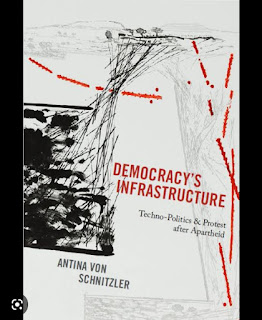HOW ELECTRICITY METERS CAME ABOUT
This book by Antina von Schnitzler an anthropologist and assistant professor in the Graduate Program in International Affairs at the New School.
The book focuses in South Africa's "miracle transition" and how it has been interrupted by waves of protests in relation to basic services such as water and electricity.
The author explores a controversial project to install prepaid water meters in Soweto. She follows engineers, utility officials, and local bureaucrats as they consider ways to prompt Sowetans to pay for water and she shows how local residents and activists wrestle with the constraints imposed by meters.
Below is a time line of how electricity meter came about.
DEMOCRACY'S INFRASTRUCTURE, APARTHEID DEBRIS
Von Schnitzler, A. 2016. Democracy’s infrastructure : techno-politics and protest after apartheid. Princeton: Princeton University Press.
Diepsloot was only the beginning of a series of protests all over the country that would continue in years to come ( Von Schnitzler, 2016: 4).
2013 Police statistics showed a massive incidence of protests while many journalists regularly called South Africa the "protest capital" of the work.
2015. Gauteng Premier announced that the province was setting up "war rooms" in each community to deal with the protests directly.
"The post apartheid period has been defined by widespread acts involving infrastructures such as; non payment of service charges, the bypassing, tampering, or distraction of water and electricity meters and illegal connections to services"( Von Schnitzler, 2016:4).
THE SOCIAL LIFE OF A PREPAID METER
"Prepaid meter is a device which apart from measuring networked services such as electricity, gas or water automatically disconnects users in cases of non payment" ( Von S chnitzler, 2016:5).
To access the services the users have to purchase and load up credit tokens in advance, either by entering a numerical code or by using a magnetic key or card.Failure to do so results i disconnection.
HISTORY OF ELECTRIC METERS
1980. Meters were first deployed to help combat the apartheid rent refusal. Prepaid meters have become present everywhere, making South Africa the place with the largest number of installed prepaid meters (Von Schnitzler, 2016: 6).
"Living Prepaid" with often only temporary access to services and flows of water and electricity, especially electricity is scarce in South Africa due to loadshedding punctuated every so often by cutoffs, has become a norm for many poorer residents of informal settlements and townships. Power cutoffs have became a national struggle in South Africa.
"In the 19th century Britain the first prepaid meter was invented to extend gas to the working class"( Von Schnitzler, 2016: 7).
1980. The prepaid meter was then allocated and redeveloped in South Africa by apartheid era engineers as a technical tool to counter the anti apartheid " rent boycotts". the meters were renamed "Budget Energy Controller".
- Apartheid was about infrastructure which created racial fordism. " Apartheid aspired to create a thoroughly engineered society, founded on a trust in numbers and techno-scientific expertise" (Von Schnitzler, 2016: 13).
- In 1980s the link between infrastructure and security intensified, as emergency provisions gave the military powers to assume command over basic services, such as water and electricity and evictions in the apartheid South Africa were carried out in the presence of the military and security forces.
1955. Freedom Charter laid out a non racial, democratic future where South Africa will be governed by "the people". Inequality will come to an end.
1970-1980. Infrastructural terrain emerged as one of the most important arenas of antiapartheid struggles to answer questions regarding citizenship, political rights and belonging ( Von Schnitzler, 2016: 14).
OPERATION GCINAMANZI ( SAVE WATER)
1990. Many social movements and community groups had begun targeted organizing around infrastructure and basic services such as housing, water and elecrticity.
1996. New social movements became evident in Diepsloot as a consequence of the conservative Growth Employment and Redistribution (GEAR) strategy to Igoli.
"THE MOST VOCAL OPPOSITION EMERGED OPERATION GCINAMANZI ( ZULU FOR 'SAVE WATER') THIS WAS A, MULTILAYERED INFRASTRUCTURE PROJECT INITIATED BY THE JOHANNESBURG WATER COMPANY TO UPGRADE SOWETO'S WEAK INFRASTRUCTURE AND TO INSTALL PREPAID WATER METERS IN ALL OF ITS HOUSEHOLDS" (Von Schnitzler, 2016:15)
2003. Operation Gcinamanzi began with a prototype in Phiri, a poorer area of Soweto in which the utility had identified particularly high water loses.
However, the project remain unfinished today because objections to the project were muliple, raging from health concerns about water cutoffs, especially when many residents were suffering from AIDS, to complaints about a lack of consultation and persistently malfunctioning meters.
2015. Most of Soweto's over 130 000 prepaid water meter had been ignored by residents and now they are forced to install new and more secure types of meters. hence the water crisis in Soweto.
This is how meters came about in South Africa. The explanation of events is not linear and in a chronological order because the sections are divided according to headings.





I find it really interesting how politics and intersects with so many different facets of life in South Africa including infrastructure and i love the example you've highlighted here of it's really how prepaid meters were first used to combat anti-apartheid "rent boycotts".
ReplyDeleteThe acknowledgment of how access to the most basic of services such as water and electricity became important parts of the anti-apartheid struggle in the post-apartheid era. I think it's really cool how social movements and community groups have emerged to fight for access to these services. It just goes to show that infrastructure isn't just about technical stuff, but it's also about politics and society as a whole.